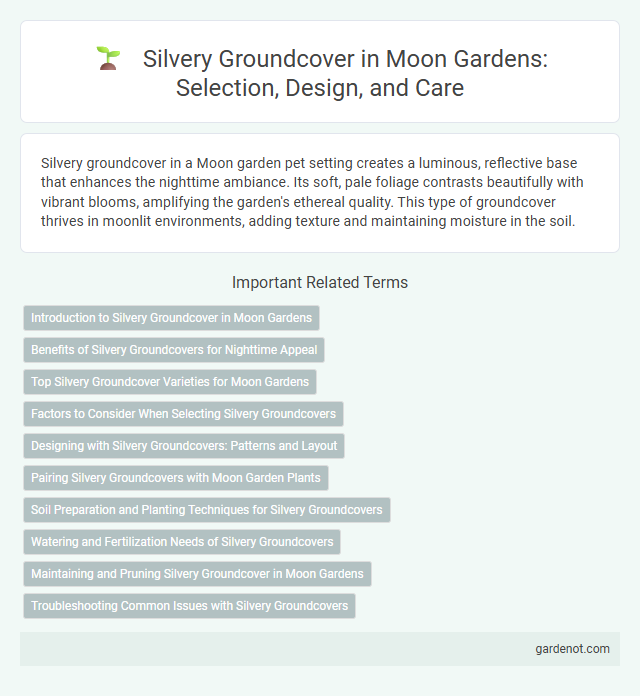Silvery groundcover in a Moon garden pet setting creates a luminous, reflective base that enhances the nighttime ambiance. Its soft, pale foliage contrasts beautifully with vibrant blooms, amplifying the garden's ethereal quality. This type of groundcover thrives in moonlit environments, adding texture and maintaining moisture in the soil.
Introduction to Silvery Groundcover in Moon Gardens
Silvery groundcover in moon gardens enhances nighttime visibility with its reflective, pale foliage that captures moonlight beautifully. Plants like Lamb's Ear (Stachys byzantina) and Artemisia 'Powis Castle' provide textured, silver-gray leaves that create a luminous carpet effect. Their low-maintenance, drought-tolerant nature complements shade-loving moon garden plants, promoting a serene and ethereal nighttime landscape.
Benefits of Silvery Groundcovers for Nighttime Appeal
Silvery groundcovers enhance nighttime appeal by reflecting moonlight, creating a luminous and ethereal garden atmosphere. Their light-colored foliage increases visibility and highlights garden paths and features after dark. These plants also add texture and depth to moon gardens, providing contrast against darker foliage and nighttime shadows.
Top Silvery Groundcover Varieties for Moon Gardens
Silvery groundcovers such as Lamb's Ear (Stachys byzantina) and Silver Mound Artemisia are top choices for moon gardens due to their reflective foliage that enhances nighttime ambiance. These varieties thrive in well-drained soil and full to partial sun, creating a luminous contrast against darker plants. Their low maintenance and drought tolerance make them ideal for sustainable, visually striking moon garden designs.
Factors to Consider When Selecting Silvery Groundcovers
When selecting silvery groundcovers for a moon garden, consider factors such as light exposure, soil type, and water requirements to ensure optimal growth and visual impact. Choose drought-tolerant varieties like Lamb's Ear (Stachys byzantina) or Silver Mound Artemisia that thrive in well-drained soils and full to partial sun. Assess the plant's growth habit and maintenance needs, favoring low-growing, spreading types that enhance nighttime garden illumination without overwhelming other elements.
Designing with Silvery Groundcovers: Patterns and Layout
Silvery groundcovers create striking contrast in moon garden designs, enhancing nighttime visibility and texture with their reflective foliage. Arranging these plants in flowing patterns or geometric layouts highlights their luminous quality, balancing soft, rounded forms against darker greenery for dynamic visual interest. Strategic placement around pathways or under moonlight-reflecting plants maximizes the ethereal, shimmering effect central to moon garden aesthetics.
Pairing Silvery Groundcovers with Moon Garden Plants
Silvery groundcovers such as Lamb's Ear (Stachys byzantina) and Artemisia complement moon garden plants by enhancing their nighttime glow with contrasting textures and reflective foliage. These groundcovers thrive in well-drained soil and full sun, providing a soft, luminous base that amplifies the ethereal effect of white blooms like Night-Blooming Jasmine and Moonflower. Incorporating silvery groundcovers creates a cohesive moon garden aesthetic, increasing visual interest and maintaining moisture while requiring minimal maintenance.
Soil Preparation and Planting Techniques for Silvery Groundcovers
Optimal soil preparation for silvery groundcovers involves well-draining, sandy or loamy soil enriched with organic compost to enhance moisture retention and nutrient availability. Plant silvery groundcovers in areas with partial to full sun exposure, spacing them 12-18 inches apart to allow healthy root expansion and air circulation. Incorporate mulch around the plants to regulate soil temperature and reduce weed competition, promoting vigorous growth and long-lasting silvery foliage display.
Watering and Fertilization Needs of Silvery Groundcovers
Silvery groundcovers thrive in well-drained soil with moderate watering, requiring moisture retention without waterlogging to prevent root rot. Fertilization should be light and balanced, using a slow-release, low-nitrogen fertilizer in early spring to promote healthy foliage while maintaining the plant's silvery sheen. Over-fertilization can cause excessive leaf growth that diminishes the characteristic silvery appearance, so careful nutrient management is crucial for optimal garden beauty.
Maintaining and Pruning Silvery Groundcover in Moon Gardens
Maintaining silvery groundcover in moon gardens requires regular monitoring to prevent overgrowth and maintain its ethereal appeal. Pruning should focus on trimming back leggy or damaged stems early spring to encourage dense, healthy foliage that enhances nighttime illumination. Consistent removal of spent leaves and occasional thinning improves air circulation, preserving the plant's silvery sheen and overall garden harmony.
Troubleshooting Common Issues with Silvery Groundcovers
Silvery groundcovers often struggle with fungal diseases like powdery mildew due to poor air circulation and excessive moisture. To troubleshoot, improve drainage, reduce overhead watering, and apply fungicides as needed to prevent spreading. Regularly inspect leaves for discoloration or spots to catch early signs of infestation and maintain plant health.
Silvery groundcover Infographic

 gardenot.com
gardenot.com